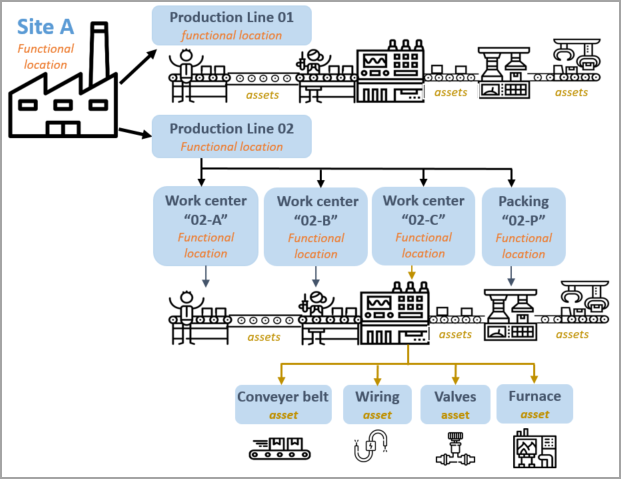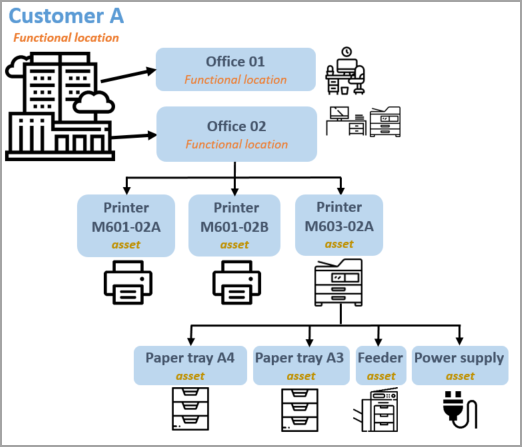Functional locations and assets
The following sections describe the key components of Asset Management.
Functional locations
Functional locations are used to track physical assets and their locations. Examples of locations can include plants, warehouses, yards, and office buildings.
- They are structured hierarchically, and locations can have sub locations.
- The structure of functional locations cannot be changed after they have been created. In other words, locations can’t move.
- How you build your hierarchy of functional locations depends on your company's organizational structure and preferences.
The following figure is an example of a functional location based on a site.

This example features the Munson's Pickles and Preserves Farm company. This sample is a salsa plant (titled Site A) and is a functional location where assets that are installed at this functional location are used to make salsa.
Production Line 01, another functional location, creates the labels for the jars and attaches them to the jars by using machinery (assets).
Production line 02, functional location, is where they are making the salsa at the various work centers. These centers, too, are functional locations that use the following assets:
- Work center 02-A prepares the ingredients for the salsa.
- Work center 02-B mixes the ingredients and adds spices together.
- Cooking the salsa occurs at the functional location Work center 02-C.
- Packing 02-P is where the labeled jars are packed for delivery.
The following list summarizes functional locations:
- Functional locations are the places where assets are “installed” or located.
- Functional locations can be established hierarchically to include sub locations.
- Sub locations can have sub locations.
- Assets are the equipment that is used such as the conveyer belt, machinery to cook the salsa, and so on.
The following example shows a functional location based on a customer.

This example shows a functional location where a corporate office is Customer A. Within Customer A, offices represent locations. In this example, Office 01 and Office 02 could be a desk or work area. Office 02 is a work area with printers and assets installed.
Assets
Assets are the physical equipment and machinery, such as conveyer belts, forklifts, and the parts and tools that are used to support and maintain the physical asset. The following list describes key information about assets:
- Assets can be organized in a hierarchical structure or they can be organized by functional locations.
- Assets can be installed on functional locations and, if needed, can be moved to or installed on other functional locations. By using the example from the preceding image, the printer M601-02A, which is an asset, is located at the functional location of Company A and in Office 02 and can be moved to a different location, such as Company A and then moved to Office 01.
- Assets can have sub assets, such as spare parts for the asset.
- Asset costs always follow the location of the asset.
- If you install an asset on a new functional location, the asset automatically uses the financial dimensions that are related to the new functional location.
- This process ensures that asset costs are always related to the functional location that the asset is currently installed on.
- This automatic handling of financial dimensions helps guarantee complete tracking of costs when your company does project controlling and reporting on functional locations.